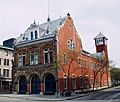Place d'Youville facts for kids
Quick facts for kids Place d'Youville |
|
|---|---|

The Grand Trunk Building viewed from Place d'Youville
|
|
| Lua error in Module:Location_map at line 420: attempt to index field 'wikibase' (a nil value). | |
| Type | Town square |
| Location | Old Montreal, Ville-Marie Montreal, Quebec, Canada |
| Created | 1901 |
| Operated by | City of Montreal |
| Status | Open all year |
Place d'Youville is a historic square in Old Montreal, a part of Montreal, Canada. It is named after Marguerite d'Youville, a famous Canadian nun. This square is where roads from Place Royale and McGill Street meet.
The square is famous for being the site of the old St. Anne's Market. This market building was once home to the Canadian government's law-making groups. These were the Legislative Council and the Assembly. They met there from 1844 to 1849. Sadly, the building was burned down on April 25, 1849.
Contents
History of Place d'Youville
It was very close to this spot that the first European settlers arrived in Montreal. This happened in 1642. The Saint-Pierre river used to flow through this area. Because the area often flooded, the settlers soon moved to higher ground. This new spot was near what is now rue Notre-Dame.
The Old Montreal General Hospital
For many years, the land around the square belonged to the Old Montreal General Hospital. This hospital helped people who were poor. It was built between 1692 and 1694. At first, the Charon Brothers ran the hospital. Later, in 1747, the Sisters of Charity of Montreal took over. These sisters are also known as the Grey Nuns. Their group was started by Marie-Marguerite d'Youville.
The Sainte-Anne Market
Being close to the port made the area important again. In 1833, the marché Sainte-Anne (Sainte-Anne Market) was built. It was a place for people to sell fruits and vegetables. The market building had a beautiful Georgian style. It had two long sections and a main entrance with a portico. A small steeple sat on top of the central part.
The marché Sainte-Anne was so nice that the government decided to use it. The Parliament of the Province of Canada moved into it in 1844. Here, leaders from Upper Canada (now southern Ontario) and Lower Canada (now Quebec) met. A second market building was built behind the Parliament in 1844. This new building took over the old market's job.
The Burning of the Parliament
On April 25, 1849, the Parliament building was burned down. This happened because English-speaking protesters were angry. They did not like a new law called the Rebellion Losses Bill. This law would pardon people who had been involved in the Lower Canada Rebellion. The protesters drove the leaders out and set the building on fire. After this event, Montreal was no longer the capital city of Canada.
Changes to the Square
The market building was rebuilt in 1852. It became a public market again, and a fish market was added later. In 1871, the Grey Nuns moved to a new home. This new place was on René Lévesque Boulevard, which was then in the countryside.
To make way for rue Saint-Pierre leading to the port, their old chapel was torn down. Only parts of the walls and old windows remained. Other buildings were also removed to create space for rue Normand. In 1901, the St. Anne's Market and the fish market were demolished. This cleared the center of the neighborhood. New shops, public buildings, and offices moved in. At this time, the City of Montreal decided to name the area "place d'Youville". It was named after Marie-Marguerite d'Youville, who was one of its first residents.
Images for kids
-
The Centre d'histoire de Montréal, next to the fire station.
What You Can See Today
Today, Place d'Youville is home to several interesting places:
- The Pointe-à-Callière Museum is nearby.
- Since 2001, a part of the area has been called Place de la Grande-Paix-de-Montréal.
- In the center of the square, an old army building now houses the Centre d'histoire de Montréal. This is a history center for Montreal.
- You can also see a public artwork by Gilles Mihalcean. It is called La Peur, which means Fear.





